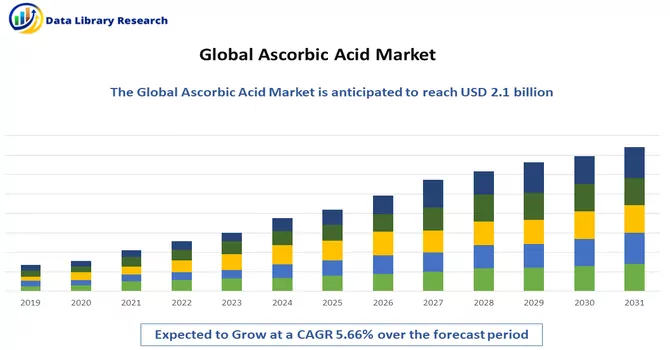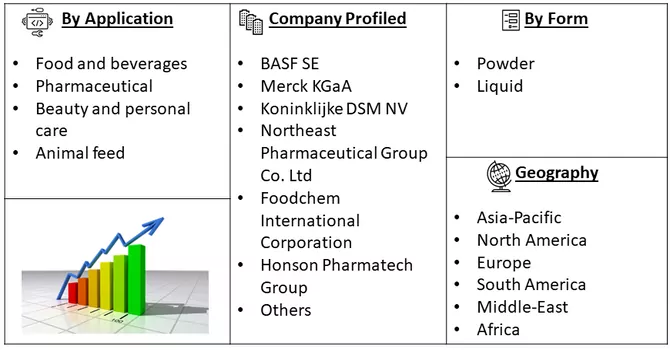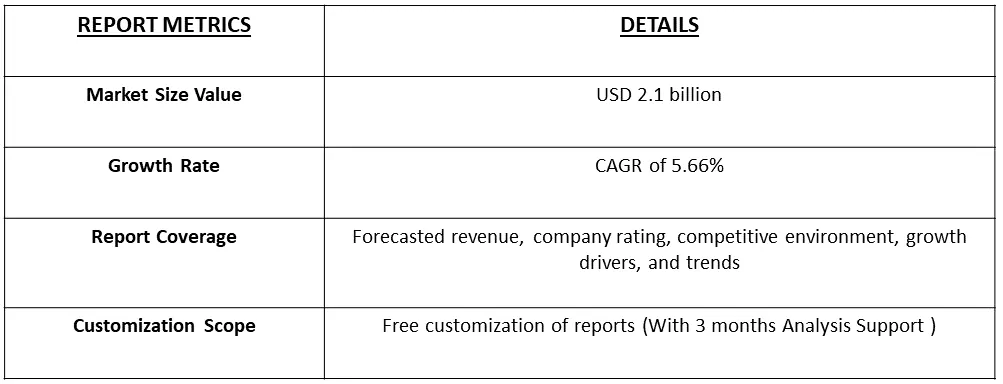The Ascorbic Acid Market size is estimated at USD 2.1 billion in 2023 and is expected to register a CAGR of 5.66% during the forecast period (2024-2031).

Get Complete Analysis Of The Report - Download Free Sample PDF
Ascorbic acid, also known as vitamin C, is a water-soluble vitamin and a powerful antioxidant. It is essential for various biological functions in the human body, including the synthesis of collagen, absorption of iron, maintenance of the immune system, and protection against oxidative stress. Ascorbic acid is naturally found in many fruits and vegetables, particularly citrus fruits like oranges and lemons, strawberries, kiwi, and bell peppers. It plays a crucial role in supporting the health of skin, blood vessels, bones, and connective tissues. Additionally, vitamin C is known for its ability to scavenge free radicals, which are unstable molecules that can cause cellular damage. Because the human body cannot produce vitamin C on its own, it must be obtained through dietary sources or supplements. A deficiency of ascorbic acid can lead to a condition known as scurvy, characterized by weakness, fatigue, and joint pain.
The ascorbic acid market is experiencing robust growth driven by several key factors. The rising demand in the food and beverage industry for its preservative and antioxidant properties, coupled with the increasing awareness of health and wellness benefits, has led to a surge in the use of ascorbic acid in dietary supplements and functional foods. Additionally, its applications in the cosmetics, pharmaceutical, and animal feed industries further contribute to market expansion. Technological advancements in production processes have enhanced efficiency, while the preference for natural and organic products has spurred the development of plant-based sources of vitamin C. The global population growth, urbanization, and changing lifestyles also play a role, creating opportunities for stakeholders in the ascorbic acid market.
The ascorbic acid market is undergoing notable shifts influenced by evolving consumer preferences and global market dynamics. A discernible trend is the increasing demand for natural and plant-based sources of ascorbic acid, with consumers favoring options like acerola cherry, rose hips, and botanical extracts for their clean label and organic attributes. Concurrently, companies in the market are concentrating on product innovation, formulating novel delivery formats for supplements, fortified foods, and skincare products to enhance bioavailability and consumer convenience. Furthermore, there is a significant expansion in the functional foods and nutraceuticals segment, driven by a growing interest in health and wellness. Ascorbic acid is being increasingly incorporated into products such as energy drinks, fortified beverages, and immunity-boosting snacks, contributing to overall market growth. The rise of e-commerce platforms is also playing a pivotal role, facilitating easy access to a diverse array of ascorbic acid-containing products through online retail channels. Companies are responding to the heightened awareness of environmental concerns by focusing on sustainable sourcing and production practices, exploring eco-friendly manufacturing processes and sustainable supply chains to meet consumer expectations for environmentally conscious products. The market is also witnessing heightened demand fueled by the global emphasis on health and immunity, leading consumers to proactively seek vitamin C supplements and fortified foods. Amidst these trends, regulatory compliance and adherence to quality standards are gaining increased significance, with manufacturers investing in measures to ensure compliance with regulations, certifications, and quality assurance, thereby building consumer trust. The ascorbic acid market is not immune to global supply chain challenges, including fluctuations in raw material prices, geopolitical factors, and disruptions, all of which impact the market's stability and pricing trends. Collectively, these trends underscore the dynamic nature of the ascorbic acid market, shaped by consumer preferences, industry innovations, and global factors.
Market Segmentation:
The Global Ascorbic Acid Manufacturers Market is Segmented by Application (Food and Beverage, Pharmaceuticals, and Healthcare, Beauty and Personal Care, and Animal Feed) and Geography (North America, Europe, Asia-Pacific, South America, and Middle-East and Africa). The market size and forecasts are provided in terms of value (USD million) for all the above segments.

For Detailed Market Segmentation - Download Free Sample PDF
Market Drivers:
Increasing global emphasis on health and wellness
A surge in the worldwide prioritization of health and well-being has fueled a rising need for products that actively contribute to overall health. Ascorbic acid, renowned for its pivotal role in supporting the immune system and providing various health benefits, is witnessing an increased demand. This heightened interest is particularly evident as consumers actively seek out nutritional supplements and fortified foods that incorporate ascorbic acid, recognizing its value in maintaining and enhancing their overall health. This trend underscores a broader consumer shift towards proactive health-conscious choices and the incorporation of essential nutrients in daily diets to support a robust immune system and holistic well-being.
Growing consumer awareness regarding the importance of vitamin C
The surge in consumer awareness regarding the crucial role of vitamin C, also known as ascorbic acid, in preserving overall health has become a driving force behind the increased demand for products containing this essential nutrient. With a growing understanding of how vitamin C supports the immune system and contributes to skin health, consumers are actively seeking out products that incorporate ascorbic acid into their formulations. This heightened awareness is not happenstance but is a result of deliberate efforts in education and information dissemination. Educational initiatives and informational campaigns have played a pivotal role in conveying the myriad benefits of vitamin C to the public. From its immune-boosting properties to its contribution to maintaining healthy skin, these educational efforts have empowered consumers with the knowledge to make informed choices about their health and well-being. As a result, individuals are more inclined to prioritize products that contain ascorbic acid, recognizing it as a valuable component in their pursuit of a healthy lifestyle. This trend signifies a broader paradigm shift in consumer preferences, where health-conscious choices are increasingly influenced by a deeper understanding of the nutritional components that contribute to overall well-being. The interplay between consumer education, information dissemination, and the heightened demand for ascorbic acid underscores the significance of proactive health consciousness in shaping purchasing decisions. As consumers continue to seek out products aligned with their well-informed preferences, the demand for ascorbic acid-infused offerings is expected to persist and potentially grow further in health and wellness.
Market Restrains:
Environmental Impact
The ecological footprint of conventional manufacturing procedures for ascorbic acid, frequently entailing chemical synthesis, has prompted apprehensions regarding sustainability. The escalating awareness among consumers about environmental issues, coupled with the tightening grip of regulations, is likely to stimulate a growing demand for production methods that are more environmentally conscious. This trend is indicative of an evolving consumer mindset, wherein the emphasis on sustainable practices is expected to influence the ascorbic acid market. As consumers become increasingly environmentally conscious, there is a growing expectation for the industry to adopt greener manufacturing approaches, fostering innovation and sustainable practices to mitigate the environmental impact associated with traditional production methods. This shift aligns with broader global efforts to promote eco-friendly solutions and underscores the importance of adopting more sustainable practices in the production of ascorbic acid to meet the demands of an environmentally conscious market.
The COVID-19 pandemic had a multifaceted impact on the ascorbic acid market, causing disruptions in global supply chains, and leading to delays in production and distribution. However, the heightened focus on health and immunity during the crisis resulted in increased demand for ascorbic acid-containing products, with consumers seeking supplements and fortified foods. E-commerce platforms gained significance as a primary distribution channel, reflecting a shift in consumer purchasing patterns. The pandemic also influenced marketing strategies, emphasizing health benefits and natural origins. While certain end-use industries faced challenges, the ascorbic acid market adapted with resilience, with opportunities arising from the continued interest in health and wellness. Production facilities encountered difficulties due to health protocols, but innovation and evolving consumer preferences continue to shape the post-pandemic landscape of the ascorbic acid market.
Segmental Analysis:
Pharmaceuticals and Healthcare is Expected to Witness Significant Growth Over the Forecast Period
The pharmaceuticals and healthcare sectors play a crucial role in propelling the demand for ascorbic acid, also known as vitamin C. As an essential component in pharmaceutical formulations, ascorbic acid is incorporated into medications, vitamin supplements, and healthcare products, particularly due to its antioxidant properties and its role in supporting immune function. This versatile nutrient is widely utilized for wound healing, tissue repair, and skin health, promoting its inclusion in topical formulations and dermatological treatments. The convergence of the pharmaceutical and ascorbic acid markets has fostered collaborative efforts, leading to innovations in delivery methods and applications. Consumer wellness trends, emphasizing preventive healthcare, have driven the demand for healthcare products containing ascorbic acid, especially those addressing immune support and overall health maintenance. Regulatory compliance is paramount in these industries, ensuring that products meet quality standards. Moreover, global health crises, such as the COVID-19 pandemic, have intensified the demand for ascorbic acid, showcasing its relevance in times of heightened health awareness. In essence, the interplay between ascorbic acid and the pharmaceutical and healthcare sectors underscores its multifaceted significance in supporting human health and well-being.
North America Region is Expected to Witness Significant Growth Over the Forecast Period
In North America, the ascorbic acid market is dynamically influenced by a growing emphasis on health and wellness, driving increased demand for vitamin C in nutritional supplements, fortified foods, and functional beverages. Widely utilized in the pharmaceutical and nutraceutical industries for formulations supporting immune health, ascorbic acid plays a pivotal role in consumer well-being. The food and beverage sector utilizes it as a preservative and antioxidant, aligning with preferences for healthier food options. Additionally, the beauty and personal care industry incorporates ascorbic acid in skincare products, responding to the rising awareness of its skin-enhancing properties. E-commerce growth provides convenient access to ascorbic acid-containing products, while regulatory compliance ensures product quality and safety. The market is further shaped by a shift towards natural and organic products, reflecting consumer preferences for clean-label items. Recent health crises, such as the COVID-19 pandemic, have accentuated the demand for immune-boosting products, further underscoring the multifaceted significance and growth potential of the ascorbic acid market in North America.

Get Complete Analysis Of The Report - Download Free Sample PDF
The analyzed market exhibits a high degree of fragmentation, primarily attributable to the presence of numerous players operating on both a global and regional scale. The competitive landscape is characterized by a diverse array of companies, each contributing to the overall market dynamics. This fragmentation arises from the existence of specialized solution providers, established industry players, and emerging entrants, all vying for market share. The diversity in market participants is underscored by the adoption of various strategies aimed at expanding the company presence. On a global scale, companies within the studied market are strategically positioning themselves through aggressive expansion initiatives. This often involves entering new geographical regions, targeting untapped markets, and establishing a robust global footprint. The pursuit of global expansion is driven by the recognition of diverse market opportunities and the desire to capitalize on emerging trends and demands across different regions. Simultaneously, at the regional level, companies are tailoring their approaches to align with local market dynamics. Regional players are leveraging their understanding of specific market nuances, regulatory environments, and consumer preferences to gain a competitive edge. This regional focus allows companies to cater to the unique needs of local clientele, fostering stronger market penetration. To navigate the complexities of the fragmented market, companies are implementing a range of strategies. These strategies include investments in research and development to stay at the forefront of technological advancements, mergers and acquisitions to consolidate market share, strategic partnerships for synergies, and innovation to differentiate products and services. The adoption of such multifaceted strategies reflects the competitive nature of the market, with participants continually seeking avenues for growth and sustainability. In essence, the high fragmentation in the studied market not only signifies the diversity of players but also underscores the dynamism and competitiveness that drive ongoing strategic maneuvers. As companies explore various avenues for expansion, the market continues to evolve, presenting both challenges and opportunities for industry stakeholders.
Recent Development:
1) In December 2022, a strategic collaboration was unveiled as Merck KGaA and Mersana Therapeutics joined forces to pioneer the development of groundbreaking immunostimulatory antibody-drug conjugates (ADCs). This partnership marks a significant step forward for Merck KGaA, Darmstadt, Germany, reinforcing its internal capabilities and ADC strategy. The collaboration leverages the respective strengths of Merck KGaA and Mersana Therapeutics to explore innovative approaches in the realm of immunostimulatory ADCs, aiming to advance the field of targeted therapies.
2) In another noteworthy development in May 2022, Royal DSM and Firmenich successfully merged, giving rise to DSM-Firmenich, a conglomerate with four distinct business units: perfumery and beauty, food and beverage, health and nutrition, and animal nutrition. This merger brings together complementary expertise and resources, creating a diversified entity with combined sales reaching approximately EUR 11.5 billion. DSM-Firmenich now stands poised to make significant contributions across various sectors, catering to the diverse needs of the market and reflecting the ongoing trend of strategic alliances and mergers within the industry.
Q1. What was the Ascorbic Acid Market size in 2023?
As per Data Library Research the Ascorbic Acid Market size is estimated at USD 2.1 billion in 2023.
Q2. What is the Growth Rate of the Ascorbic Acid Market?
Ascorbic Acid Market is expected to register a CAGR of 5.66% during the forecast period.
Q3. Which region has the largest share of the Ascorbic Acid Market? What are the largest region's market size and growth rate?
North America has the largest share of the market. For detailed insights on the largest region's market size and growth rate request a sample here.
Q4. What are the Growth Drivers of the Ascorbic Acid Market?
Increasing global emphasis on health and wellness and Growing consumer awareness regarding the importance of vitamin C are the Growth Drivers of the Ascorbic Acid Market.
Data Library Research are conducted by industry experts who offer insight on industry structure, market segmentations technology assessment and competitive landscape (CL), and penetration, as well as on emerging trends. Their analysis is based on primary interviews (~ 80%) and secondary research (~ 20%) as well as years of professional expertise in their respective industries. Adding to this, by analysing historical trends and current market positions, our analysts predict where the market will be headed for the next five years. Furthermore, the varying trends of segment & categories geographically presented are also studied and the estimated based on the primary & secondary research.
In this particular report from the supply side Data Library Research has conducted primary surveys (interviews) with the key level executives (VP, CEO’s, Marketing Director, Business Development Manager and SOFT) of the companies that active & prominent as well as the midsized organization
FIGURE 1: DLR RESEARH PROCESS

Extensive primary research was conducted to gain a deeper insight of the market and industry performance. The analysis is based on both primary and secondary research as well as years of professional expertise in the respective industries.
In addition to analysing current and historical trends, our analysts predict where the market is headed over the next five years.
It varies by segment for these categories geographically presented in the list of market tables. Speaking about this particular report we have conducted primary surveys (interviews) with the key level executives (VP, CEO’s, Marketing Director, Business Development Manager and many more) of the major players active in the market.
Secondary ResearchSecondary research was mainly used to collect and identify information useful for the extensive, technical, market-oriented, and Friend’s study of the Global Extra Neutral Alcohol. It was also used to obtain key information about major players, market classification and segmentation according to the industry trends, geographical markets, and developments related to the market and technology perspectives. For this study, analysts have gathered information from various credible sources, such as annual reports, sec filings, journals, white papers, SOFT presentations, and company web sites.
Market Size EstimationBoth, top-down and bottom-up approaches were used to estimate and validate the size of the Global market and to estimate the size of various other dependent submarkets in the overall Extra Neutral Alcohol. The key players in the market were identified through secondary research and their market contributions in the respective geographies were determined through primary and secondary research.
Forecast Model
